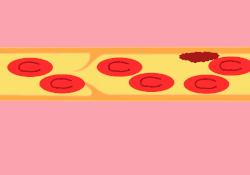Treatment
The mainstay of VTE management is anticoagulation therapy, which prevents thrombus propagation and embolization. Such treatment reduces the risk of recurrence. [5] [4] [1] The choice and duration of anticoagulation depend on the individual patient's risk factors, bleeding risk, and preferences.
Direct oral anticoagulants (DOACs) have emerged as an essential alternative to conventional anticoagulants, such as vitamin K antagonists (VKAs) and low-molecular-weight heparins (LMWHs), due to their rapid onset of action, predictable pharmacokinetics, fixed dosing, and lower risk of bleeding. DOACs can also facilitate home treatment and extended therapy for selected patients.
In addition to anticoagulation, some patients with VTE may benefit from adjunctive therapies, such as thrombolysis, catheter-directed interventions, or inferior vena cava (IVC) filters, to remove or prevent thrombus migration. However, these therapies are associated with higher risks of bleeding and complications. These therapies are not routinely recommended by the current guidelines except for specific indications, such as massive PE, iliofemoral DVT, or contraindications to anticoagulation.
The optimal duration of anticoagulation for VTE is determined by the balance between the risk of recurrence and the risk of bleeding, and should be individualized for each patient. In general, VTE provoked by a transient or reversible risk factor, such as surgery, trauma, or immobilization, should be treated for three months, while VTE provoked by a persistent or progressive risk factor, such as cancer, should be treated indefinitely. Unprovoked VTE, which occurs in the absence of any identifiable risk factor, has a high risk of recurrence and may require indefinite anticoagulation, depending on the patient's characteristics and preferences. [4] [7] [8] The risk of recurrence of thrombosis also plays a role in treatment duration. In general, patients who experience a major reversible risk factor such as major trauma or surgery, have a lower incidence of recurrence and require less treatment time. [9] Those whose thrombosis is brought on by a minor reversible risk factor have a higher change of recurrent thrombus and require longer treatment time. These events include long flights, estrogen therapy, pregnancy and peripartum, and minor leg traumas. [9] It should also be noted that all patients with a first time VTE, regardless of what brought on the initial thrombosis, have a 50% chance of recurrence in the first 8-10 years after anticoagulation is discontinued. [9]
Factors that favor indefinite anticoagulation include male sex, presentation as PE (especially with concomitant DVT), positive d-dimer test after stopping anticoagulation, presence of antiphospholipid antibodies, low bleeding risk, and patient preference. [3] The type of anticoagulant used for indefinite therapy is of secondary importance, but low-dose DOACs may offer a convenient and safer option for some patients. [4] [7] [8] For cancer-associated VTE, full-dose DOACs are now preferred over LMWHs, unless there are gastrointestinal lesions that increase the risk of bleeding. [4] [7] [8]
Graduated compression stockings are elastic garments that apply a gradient of pressure to the lower limbs, reducing venous stasis and improving blood flow, still these stockings are not routinely indicated after DVT, but may be helpful if there is persistent leg swelling or symptomatic improvement with a trial of stockings. [3] [10] Medications, such as pentoxifylline, have a limited role in the treatment of PTS. After PE, patients should be monitored for signs and symptoms of CTEPH, which is a rare but serious complication of VTE. [4] [7] [8] Ventilation-perfusion scanning and echocardiography are the initial diagnostic tests for CTEPH, and patients with confirmed or suspected CTEPH should be evaluated for potential treatments, such as pulmonary thromboendarterectomy, balloon pulmonary angioplasty, or vasodilator therapies. [3]
Risk factors
There are several factors that increase the risk of developing a VTE. [11]
High risk: bone fracture (especially of the hip or leg), recent hip or knee replacement, recent major general surgery, spinal cord injuries, and major trauma. [11]
Moderate risk: arthroscopic knee surgery, central venous lines, chemotherapy, congestive heart failure, respiratory failure, hormone replacement therapy, cancer, use of oral contraceptives, pregnancy and the postpartum period, history of a previous VTE, and conditions such as thrombophilia. [11]
Low risk: prolonged immobility (long car/plane ride, bed rest duration at least 3 days), increased age, laparoscopic surgery, obesity, and varicose veins. [11]
